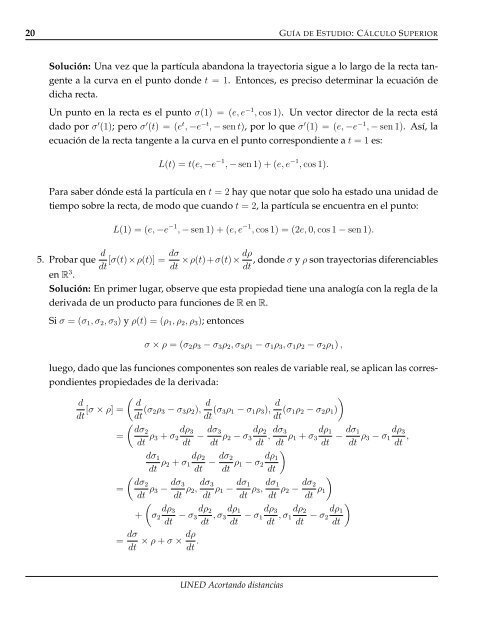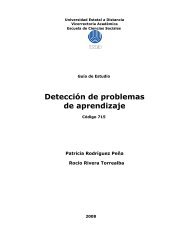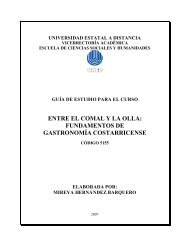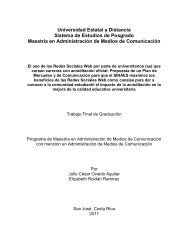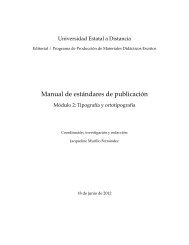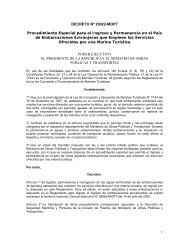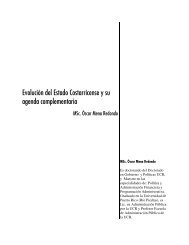GE3011 Cálculo Superior - Repositorio de la Universidad Estatal a ...
GE3011 Cálculo Superior - Repositorio de la Universidad Estatal a ...
GE3011 Cálculo Superior - Repositorio de la Universidad Estatal a ...
Create successful ePaper yourself
Turn your PDF publications into a flip-book with our unique Google optimized e-Paper software.
20 GUÍA DE ESTUDIO: CÁLCULO SUPERIOR<br />
Solución: Una vez que <strong>la</strong> partícu<strong>la</strong> abandona <strong>la</strong> trayectoria sigue a lo <strong>la</strong>rgo <strong>de</strong> <strong>la</strong> recta tan-<br />
gente a <strong>la</strong> curva en el punto don<strong>de</strong> t = 1. Entonces, es preciso <strong>de</strong>terminar <strong>la</strong> ecuación <strong>de</strong><br />
dicha recta.<br />
Un punto en <strong>la</strong> recta es el punto σ(1) = (e, e −1 , cos 1). Un vector director <strong>de</strong> <strong>la</strong> recta está<br />
dado por σ ′ (1); pero σ ′ (t) = (e t , −e −t , − sen t), por lo que σ ′ (1) = (e, −e −1 , − sen 1). Así, <strong>la</strong><br />
ecuación <strong>de</strong> <strong>la</strong> recta tangente a <strong>la</strong> curva en el punto correspondiente a t = 1 es:<br />
L(t) = t(e, −e −1 , − sen 1) + (e, e −1 , cos 1).<br />
Para saber dón<strong>de</strong> está <strong>la</strong> partícu<strong>la</strong> en t = 2 hay que notar que solo ha estado una unidad <strong>de</strong><br />
tiempo sobre <strong>la</strong> recta, <strong>de</strong> modo que cuando t = 2, <strong>la</strong> partícu<strong>la</strong> se encuentra en el punto:<br />
L(1) = (e, −e −1 , − sen 1) + (e, e −1 , cos 1) = (2e, 0, cos 1 − sen 1).<br />
5. Probar que d<br />
dσ<br />
dρ<br />
[σ(t)×ρ(t)] = ×ρ(t)+σ(t)× , don<strong>de</strong> σ y ρ son trayectorias diferenciables<br />
dt dt dt<br />
en R3 .<br />
Solución: En primer lugar, observe que esta propiedad tiene una analogía con <strong>la</strong> reg<strong>la</strong> <strong>de</strong> <strong>la</strong><br />
<strong>de</strong>rivada <strong>de</strong> un producto para funciones <strong>de</strong> R en R.<br />
Si σ = (σ1, σ2, σ3) y ρ(t) = (ρ1, ρ2, ρ3); entonces<br />
σ × ρ = (σ2ρ3 − σ3ρ2, σ3ρ1 − σ1ρ3, σ1ρ2 − σ2ρ1) ,<br />
luego, dado que <strong>la</strong>s funciones componentes son reales <strong>de</strong> variable real, se aplican <strong>la</strong>s corres-<br />
pondientes propieda<strong>de</strong>s <strong>de</strong> <strong>la</strong> <strong>de</strong>rivada:<br />
<br />
d<br />
d<br />
[σ × ρ] =<br />
dt<br />
=<br />
dt (σ2ρ3 − σ3ρ2), d<br />
dt (σ3ρ1 − σ1ρ3), d<br />
dt (σ1ρ2<br />
<br />
− σ2ρ1)<br />
<br />
dσ2<br />
dt ρ3<br />
dρ3 dσ3<br />
+ σ2 −<br />
dt dt ρ2<br />
dρ2 dσ3<br />
− σ3 ,<br />
dt dt ρ1<br />
dρ1<br />
+ σ3<br />
dt<br />
dσ1<br />
dt ρ2<br />
dρ2 dσ2<br />
+ σ1 −<br />
dt dt ρ1<br />
dρ1<br />
− σ2<br />
dt<br />
<br />
dσ2<br />
=<br />
dt ρ3 − dσ3 dσ3<br />
ρ2,<br />
dt dt ρ1 − dσ1 dσ1<br />
ρ3,<br />
dt dt ρ2 − dσ2<br />
dt ρ1<br />
<br />
<br />
<br />
dρ3 dρ2 dρ1 dρ3 dρ2 dρ1<br />
+ σ2 − σ3 , σ3 − σ1 , σ1 − σ2<br />
dt dt dt dt dt dt<br />
= dσ dρ<br />
× ρ + σ ×<br />
dt dt .<br />
<br />
UNED Acortando distancias<br />
dσ1<br />
−<br />
dt ρ3<br />
dρ3<br />
− σ1<br />
dt ,


